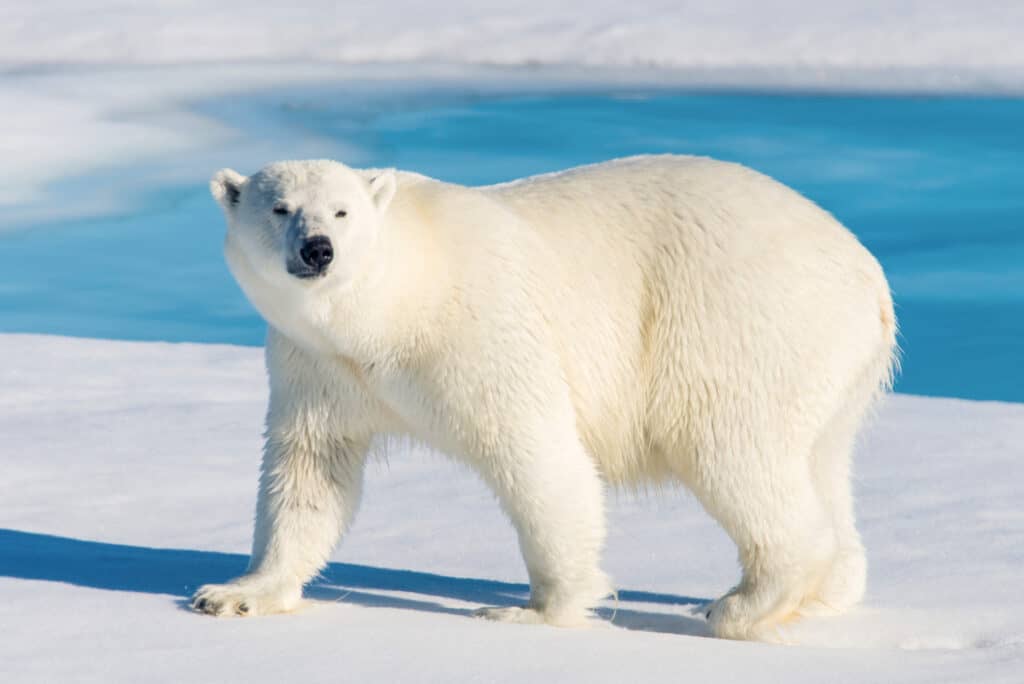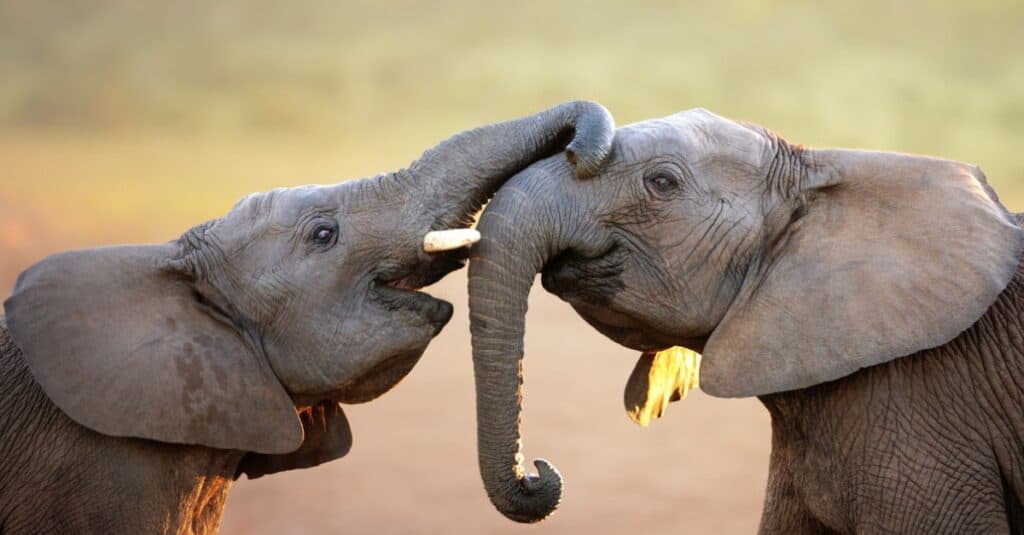As a species, humans can be downright obsessive about body fat. Given that, it’s not surprising that we love learning about the fat-to-mass ratios of other members of the animal kingdom. In this compilation of the world’s fattest animals. we list several species renowned for having high body fat percentages. Keep in mind, many animals with impressive mass don’t necessarily have a lot of body fat! For a list of massive animals with low body fat percentages, see the end of this article.
For reference, healthy human males between the ages of 20-39 should have an average body fat percentage of 8-19%. Human females in the same age range should have an average of 21-32% body fat.
Grizzly Bear
Bears are famous for being rotund, and grizzly bears are no exception. These animals spend much of their time in the spring and summer foraging for food, trying to replace lost fat reserves from the previous winter and bulking up for the impending winter. The heaviest grizzlies weigh up to 900 pounds with fat accounting for up to 40% of their mass!
Grizzlies are fattest near the end of summer or in early fall, just before they enter torpor (a less intense form of hibernation). As omnivores, they feed on a variety of foods including grasses, herbs, insects, and animals like deer, bison, and salmon.

Grizzly bears live in the western portion of the state of Montana.
©Perpis/Shutterstock.com
Elephant Seal
Most seal species have high body fat percentages, including ringed and bearded seals, but the elephant seal stands out for its extra-thick blubber. The Southern elephant seal is much larger than its Northern cousin, with bulls weighing up to 8,800 pounds. Up to 40% of their weight is comprised of body fat. Elephant seals are the largest marine mammals not classified as cetaceans. Whales, dolphins, and porpoises are cetaceans.
Elephant seals eat mainly squid and various fish, though they will also eat sharks, rays, skates, eels, and small crustaceans. They use their whiskers to detect the vibrations of passing prey. Their abundant body fat keeps them warm when they dive into the water looking for food.

Elephant seal bulls can weigh up to 8,800 pounds.
©creativex/Shutterstock.com
North Atlantic Right Whale
Whales are generally rich in fat, and the North Atlantic right whale is no exception. This whale earned its name because of its high body fat percentage. The voracious whalers of the 19th century noted that these whales would float on the surface after death, unlike other whales that commonly sank. It was the right whales’ blubber, comprising up to 45% of their body weight, that made them so buoyant. Because it was so easy to access their dead bodies, whalers considered them the right whales to hunt. Unfortunately, this has put them at risk of extinction.
North Atlantic right whales eat an astonishing amount of food per day to maintain their fat stores: up to 5,500 pounds! As filter feeders, they use their baleen plates to filter out copepods and krill larvae from seawater.

North Atlantic right whales eat up to 5,500 pounds of food per day!
©iStock.com/6381380
Polar Bear
Unsurprisingly, polar bears rank near the top of the list when it comes to body fat. These sizable carnivores live in the frigid Arctic, spending most of the winter on the ice or in the freezing water. Because of this, they need adequate protection from the cold. Their bodies pack on blubber as insulation, which comprises up to 49% of their body weight.
A polar bear’s diet is responsible for its impressive accumulation of fat. These bears eat mostly seals, specifically ringed seals. Ringed seals have a high body fat percentage themselves with a thick layer of blubber to keep them warm in the subzero waters. Polar bears wait near holes in the ice for seals to surface for air. They grab and haul their prey onto the ice, where they consume them.

Fat comprises omprises up to 49% of a
polar bear
‘s body weight.
©iStock.com/Alexey_Seafarer
2. Blue Whale
Not only is the blue whale the most massive animal on earth, but it’s also one of the fattest. Though this marine mammal typically has about 35% body fat, it can get up to a whopping 50% in times of plenty. This is incredible considering that blue whales can weigh over 300,000 pounds (150 tons!) with a tongue that weighs as much as an adult elephant. The longest blue whales grow up to 110 feet in length.
How do blue whales get so huge and pack on so much fat? They eat impressive amounts of krill, a common type of crustacean. Blue whales suck water and krill into their mouths, then filter the water out through baleen plates made of keratin. The largest blue whales consume about 7,700 pounds, or four tons, of krill a day.

The blue whale is the most massive animal on earth.
©Robert Pitman / public domain – License
Army Cutworm Moth
The fattest animal on our list is also the tiniest, proving that sheer size isn’t a reliable indicator of fatness. The army cutworm moth is a favourite meal of Yellowstone grizzly bears trying to pack on the pounds for winter. This isn’t surprising, given that these moths can attain a body fat percentage of up to 72% by autumn.
Army cutworms are greyish-brown with a wingspan of one to two inches. During the summer and early fall, they rapidly put on fat due to a diet rich in wildflower nectar. Grizzly bears eat them in large quantities during this time, taking advantage of their tendency to gather by the thousands in fields of boulders.

The army cutworm moth is the fattest animal on our list, but also also the tiniest.
©William Cushman/Shutterstock.com
Massive Animals with Low Body Fat Percentages
Are you surprised that certain animals didn’t make our compilation of the world’s fattest animals? Check out the following creatures that look fat but actually aren’t.
- Elephant: You might be shocked to learn that you’re probably fatter than an elephant. Healthy male elephants typically have about 8.5% body fat while healthy female elephants have about 10% body fat. This is significantly less than their average human counterparts. Here’s a link to the original study measuring elephant body fat percentages.
- Hippopotamus: Hippos appear incredibly bulbous to observers, but did you know that most of their mass is muscle and bone? Hippopotami have a very thin layer of subcutaneous fat under a thick layer of skin. Unlike their body fat, their skin makes up a significant portion of their total body weight, about 18%. Adult male hippos can reach a weight of up to 9,900 pounds.
- Rhinoceros: Rhinos are similar to hippos in terms of their muscle-to-fat ratio. Though rhinoceroses appear extremely chunky and can weigh nearly 8,000 pounds, most of this is muscle and bone. Their inflated stomachs are the result of large stomachs and intestinal tracts, not fat.

Percentage-wise, elephants have less body fat than humans!
©iStock.com/johan63
The next time you look at an animal, just remember: size can be deceptive! The largest animals aren’t necessarily the fattest. Check out this article for a list of the fattest animals according to how much they eat compared to their body size.
Up Next:
- The 10 Largest Animals in the World
- The Biggest Land Animal on Earth
- Blue Whale Size Comparison: Just How Big is the Biggest Animal in the World?
The photo featured at the top of this post is © AndreAnita/Shutterstock.com
Sources
- NyPost, Available here: https://nypost.com/2021/01/27/humans-are-fatter-than-elephants-according-to-science/
- Forbes, Available here: https://www.forbes.com/health/body/body-fat-percentage/
- journals.biologist.com, Available here: https://journals.biologists.com/jeb/article/224/2/jeb219543/237129/Adiposity-reproductive-and-metabolic-health-and
- bearbiology, Available here: https://www.bearbiology.org/fileadmin/tpl/Downloads/URSUS/Vol_9/French_French_Vol_9.pdf
- rom.on.ca, Available here: https://www.rom.on.ca/en/collections-research/magazine/the-right-kind-of-whale
Thank you for reading! Have some feedback for us? Contact the AZ Animals editorial team.






